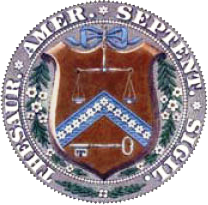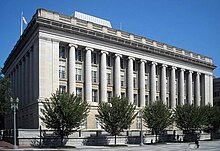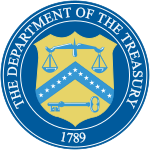United States Department of the Treasury
Marilynn Malerba, Treasurer | |
| Child agencies | |
|---|---|
| Website | treasury.gov |
The Department of the Treasury (USDT)
The department was established by an Act of Congress in 1789 to manage government revenue.[6] The first secretary of the treasury was Alexander Hamilton, who was sworn into office on September 11, 1789.[7] Hamilton was appointed by President George Washington on the recommendation of Robert Morris, Washington's first choice for the position, who had declined the appointment.[8] Hamilton established the nation's early financial system and for several years was a major presence in Washington's administration.[9] The department is customarily referred to as "Treasury", solely, without any preceding article, as a remnant of the country's transition from British to American English during the late 18th century. Hamilton's portrait appears on the obverse of the ten-dollar bill, while the Treasury Department building is depicted on the reverse.[10]
History
Revolutionary period
The history of the Department of the Treasury began in the turmoil of the
On July 29, 1775, the
Despite the infusion of foreign and domestic loans, the united colonies were unable to establish a well-organized agency for financial administration. Michael Hillegas was first called Treasurer of the United States on May 14, 1777. The Treasury Office was reorganized three times between 1778 and 1781. The $241.5 million in paper Continental bills devalued rapidly. By May 1781, the dollar collapsed at a rate of from 500 to 1000 to 1 against hard currency. Protests against the worthless money swept the colonies, giving rise to the expression "not worth a Continental". The office has, since the late 18th century, been customarily referred to as the singular "Treasury", without any preceding article, as a remnant of the country's transition from British to American English.[12][13] For example, the department notes its guiding purpose as "Treasury's mission" instead of "the Treasury's mission."[14]
Robert Morris was designated Superintendent of Finance in 1781 and restored stability to the nation's finances. Morris, a wealthy colonial merchant, was nicknamed "the financier" because of his reputation for procuring funds or goods on a moment's notice. His staff included a comptroller, a treasurer, a register, and auditors, who managed the country's finances through 1784, when Morris resigned because of ill health. The treasury board, consisting of three commissioners, continued to oversee the finances of the confederation of former colonies until September 1789.
Creation of the Treasury

The
To the surprise of many legislators, he insisted upon
The Department of Treasury believes their seal was created by Francis Hopkinson, the treasurer of loans. He submitted bills to Congress in 1780 that authorized the design of department seals, including the seal for the Board of Treasury. While it is not certain that Hopkinson designed the seal, it is very similar to others he has done.[17]
2003 reorganization
The
Effective March 1, 2003, the
2020 data breach
In 2020, the Treasury
Responsibilities



Basic functions
The basic functions of the Department of the Treasury mainly include:[24]
- Producing all currency and coinage of the U.S.;
- Collecting taxes, dutiesand money paid to and due to the U.S.;
- Paying all bills of the U.S.;
- Managing the federal finances;
- Managing government accounts (including the United States public debt;
- Supervising national banks and thrift institutions;
- Advising on domestic and international financial, monetary, economic, trade and tax policy (fiscal policy being the sum of these);
- Enforcing federal finance and tax laws;
- Investigating and prosecuting tax evaders;
- Publishing statistical reports.
With respect to the estimation of revenues for the
From 1830 until 1901, responsibility for overseeing
Organization
The Department of the Treasury is organized into two major components: the departmental offices and the operating bureaus. The departmental offices are primarily responsible for the formulation of policy and management of the department as a whole, while the operating bureaus carry out the specific operations assigned to the department.
Structure

- Secretary of the Treasury[26]
- Deputy Secretary of the Treasury
- Treasurer of the United States
- Under Secretary for Domestic Finance[27]
- Assistant Secretary for Financial Institutions
- Assistant Secretary for Financial Markets
- Fiscal Assistant Secretary
- Under Secretary for International Affairs[28]
- Assistant Secretary for International Markets and Development
- Assistant Secretary for International Finance
- Assistant Secretary of the Treasury for Investment Security[29]
- Office of Environment and Energy[30]
- Under Secretary for Terrorism and Financial Intelligence (Office of Terrorism and Financial Intelligence)[31]
- Assistant Secretary for Terrorist Financing
- Assistant Secretary for Intelligence and Analysis
- Financial Crimes Enforcement Network
- Office of Foreign Assets Control
- Treasury Executive Office for Asset Forfeiture
- Assistant Secretary of the Treasury for Management / Chief Financial Officer / Performance Improvement Officer
- Office of Small and Disadvantaged Business Utilization
- Chief Information Officer
- Assistant Secretary for Economic Policy
- Assistant Secretary for Legislative Affairs
- Assistant Secretary for Public Affairs
- Assistant Secretary for Tax Policy
- Climate Counselor[32]
- Commissioner of Internal Revenue
- Office of the Comptroller of the Currency
- Office of Financial Research
- Office of the General Counsel
- Office of the Inspector General
- Treasury Inspector General for Tax Administration (TIGTA)
- Chief Risk Officer
- Deputy Secretary of the Treasury
Bureaus
| Bureau | Description |
| The Alcohol and Tobacco Tax and Trade Bureau (TTB) | The Alcohol and Tobacco Tax and Trade Bureau (TTB) is responsible for enforcing and administering laws covering the production, use, and distribution of alcohol and tobacco products. TTB also collects excise taxes for firearms and ammunition. |
| The Bureau of Engraving & Printing (BEP) | The Bureau of Engraving & Printing (BEP) designs and manufactures U.S. currency, securities, and other official certificates and awards. |
| The Bureau of the Fiscal Service | The Bureau of the Fiscal Service was formed from the consolidation of the Financial Management Service and the Bureau of the Public Debt. Its mission is to promote the financial integrity and operational efficiency of the U.S. government through exceptional accounting, financing, collections, payments, and shared services. |
| The Community Development Financial Institution (CDFI) Fund | The Community Development Financial Institution (CDFI) Fund was created to expand the availability of credit, investment capital, and financial services in distressed urban and rural communities. |
| The Financial Crimes Enforcement Network (FinCEN) | The Financial Crimes Enforcement Network (FinCEN) supports law enforcement investigative efforts and fosters interagency and global cooperation against domestic and international financial crimes. It also provides U.S. policymakers with strategic analyses of domestic and worldwide trends and patterns. |
| The Inspector General | The Inspector General conducts independent audits, investigations and reviews to help the Treasury Department accomplish its mission; improve its programs and operations; promote economy, efficiency and effectiveness; and prevent and detect fraud and abuse. |
| The Treasury Inspector General for Tax Administration (TIGTA) | The Treasury Inspector General for Tax Administration (TIGTA) provides leadership and coordination and recommends policy for activities designed to promote economy, efficiency, and effectiveness in the administration of the internal revenue laws. TIGTA also recommends policies to prevent and detect fraud and abuse in the programs and operations of the IRS and related entities. |
| The Internal Revenue Service | The Internal Revenue Service (IRS) is the largest of Treasury's bureaus. It is responsible for determining, assessing, and collecting internal revenue in the United States. |
| The Office of the Comptroller of the Currency (OCC) | The Office of the Comptroller of the Currency (OCC) charters, regulates, and supervises national banks to ensure a safe, sound, and competitive banking system that supports the citizens, communities, and economy of the United States. |
| The U.S. Mint | The U.S. Mint designs and manufactures domestic, bullion and foreign coins as well as commemorative medals and other numismatic items. The Mint also distributes U.S. coins to the Federal Reserve banks as well as maintains physical custody and protection of the nation's silver and gold assets. |
Budget and staffing
The Treasury Department has authorized a budget for Fiscal Year 2015 of $22.6 billion. The budget authorization is broken down as follows:[33]
| Program | Funding (in millions) | Employees (in FTEs) |
|---|---|---|
| Management and Finance | ||
| Department Administration | $311 | 1,320 |
| Office of the Inspector General | $35 | 213 |
| Inspector General for Tax Administration | $157 | 837 |
| Special Inspector General for TARP (Troubled Asset Relief Program) | $34 | 192 |
| Community Development Financial Institutions Fund | $225 | 73 |
| Financial Crimes Enforcement Network | $108 | 346 |
| Alcohol and Tobacco Tax and Trade Bureau | $101 | 517 |
| Bureau of the Fiscal Services | $348 | 2,350 |
| Tax Administration | ||
| Internal Revenue Service | $12,476 | 92,009 |
| International Programs | ||
| International Programs | $2,610 | 0 |
| Non-Appropriated Bureaus | ||
| Office of Fiscal Stability | $184 | 86 |
| Small Business Lending Programs | $17 | 25 |
| State Small Business Credit Initiative | $7 | 12 |
| Financial Stability Oversight Council | $20 | 26 |
| Office of Financial Research | $92 | 249 |
| Bureau of Engraving and Printing | $749 | 1,944 |
| United States Mint | $3,571 | 1,874 |
| Office of the Comptroller of the Currency | $1,104 | 3,997 |
| TOTAL | $22,583 | 106,080 |
Freedom of Information Act processing performance
In the latest Center for Effective Government analysis of the fifteen federal agencies that receive the most Freedom of Information Act FOIA requests, published in 2015 (using 2012 and 2013 data, the most recent years available), the treasury failed to earn a satisfactory overall grade.[34]
See also
- Federal Reserve System
- MicroLoan Program
- Title 12 of the Code of Federal Regulations
- Title 17 of the Code of Federal Regulations
- Title 19 of the Code of Federal Regulations
- Title 31 of the Code of Federal Regulations
- Treasury Enterprise Architecture Framework
- Treasury Information System Architecture Framework
- United States Coast Guard History and Heritage Sites
Notes and references
- ^ "Department of Treasury – List of Federal Departments". federalpay.org. Archived from the original on January 28, 2019. Retrieved January 28, 2019.
- ISBN 0313245789.
- ^ "An Act to Establish the Treasury Department". September 2, 1789. Archived from the original on September 14, 2018. Retrieved October 11, 2018.
- ^ "The Treasurer". U.S. Department of the Treasury. Archived from the original on April 4, 2018. Retrieved May 6, 2018.
- ^ Crutsinger, Martin (November 15, 2017). "New money: Mnuchin and Carranza signatures now on the dollar bill". USA Today. Gannett Satellite Information Network, LLC. The Associated Press. Archived from the original on May 7, 2018. Retrieved May 6, 2018.
- ^ a b "Image 1 of An act to establish the Treasury department .... [Dated] 1789, July 2. New-York. Printed by Thomas Greenleaf.]". The Library of Congress. January 1, 1970. Archived from the original on December 1, 2022. Retrieved December 1, 2022.
- ^ "Appointment as Secretary of the Treasury". founders.archives.gov. Archived from the original on March 4, 2017. Retrieved March 4, 2017.
- ^ Adams, Jonathan. "Department of the Treasury". George Washington Digital Encyclopedia. Mount Vernon Ladies' Association. Archived from the original on May 7, 2018. Retrieved May 6, 2018.
- ^ Scanlan, Laura Wolff (2006). "Alexander Hamilton: the man who modernized money". Humanities: The Magazine of the National Endowment for the Humanities. 27 (1). Archived from the original on May 7, 2018. Retrieved May 6, 2018.
- ^ "$10". U.S. Currency Education Program. Archived from the original on May 7, 2018. Retrieved May 6, 2018.
- ^ Hammond, Bray (1957). Banks and Politics in America: From the Revolution to the Civil War. Princeton, NJ: Princeton University Press.
- ^ Hamilton, Alexander (1851). Reports of the secretary of the Treasury of the United States: prepared in obedience to the act of May 10, 1800. Printed by Blair & Rives. Archived from the original on December 13, 2023. Retrieved April 27, 2020.
- ^ Dewey, Davis Rich (1922). Financial History of the United States. Longmans, Green and Company. Archived from the original on December 13, 2023. Retrieved November 22, 2020.
- ^ "Role of the Treasury | U.S. Department of the Treasury". home.treasury.gov. Archived from the original on April 29, 2020. Retrieved April 27, 2020.
Treasury's mission highlights its role as the steward of U.S. economic and financial systems, and as an influential participant in the world economy.
- ^ "Chapter 12, 1 Statue. 65" (PDF). Archived from the original (PDF) on October 19, 2017.
- ^ ISBN 978-0231089050. Archivedfrom the original on May 7, 2018. Retrieved May 6, 2018.
- ISBN 9780871840219.
- ^ "Move to Justice Dept. Brings ATF New Focus". Washington Post. January 23, 2003. Archived from the original on March 11, 2023. Retrieved March 11, 2023.
- ^ "History". TTBGov. November 18, 2015. Archived from the original on March 11, 2023. Retrieved March 11, 2023.
- ^ "Who Joined DHS". Department of Homeland Security. July 27, 2012. Archived from the original on March 11, 2023. Retrieved March 10, 2023.
- ^ Nakashima, Ellen (December 13, 2020). "Russian government spies are behind a broad hacking campaign that has breached U.S. agencies and a top cyber firm". The Washington Post. Archived from the original on December 13, 2020. Retrieved December 14, 2020.
- ^ Bing, Christopher (December 14, 2020). "Suspected Russian hackers spied on U.S. Treasury emails – sources". Reuters. Archived from the original on December 14, 2020. Retrieved December 14, 2020.
- ^ Office, U. S. Government Accountability (March 21, 2024). "SolarWinds Cyberattack Demands Significant Federal and Private-Sector Response (infographic) | U.S. GAO". www.gao.gov. Retrieved April 10, 2024.
- ^ US Treasury website Organization Archived October 11, 2011, at the Wayback Machine
- ^ Records of the National Institute of Standards and Technology (NIST) Archived October 19, 2017, at the Wayback Machine, National Archives website, (Record Group 167), 1830–1987.
- ^ Treasury Order 101-05 Archived March 19, 2021, at the Wayback Machine, U.S. Dept. of the Treasury. January 10, 2011. Updated April 26, 2011. Accessed November 11, 2012.
- ^ DF Org Chart Archived January 16, 2022, at the Wayback Machine, "The Office of Domestic Finance". U.S. Dept. of the Treasury. October 2011. Accessed November 11, 2012.
- ^ International Affairs Archived June 22, 2016, at the Wayback Machine, "About International Affairs". U.S. Dept. of the Treasury. February 14, 2012. Accessed November 11, 2012.
- ^ "Officials | U.S. Department of the Treasury". home.treasury.gov. Archived from the original on September 22, 2018. Retrieved April 20, 2021.
- ^ "Environment and Energy". www.treasury.gov. Archived from the original on November 7, 2017. Retrieved October 30, 2017.
- ^ Terrorism and Financial Intelligence Archived September 5, 2015, at the Wayback Machine, "About Terrorism and Financial Intelligence". U.S. Dept. of the Treasury. July 2, 2012. Accessed November 11, 2012.
- ^ "Treasury Announces Coordinated Climate Policy Strategy with New Treasury Climate Hub and Climate Counselor | U.S. Department of the Treasury". home.treasury.gov. Archived from the original on April 20, 2021. Retrieved April 20, 2021.
- ^ 2015 Department of the Treasury Budget in Brief Archived July 14, 2014, at the Wayback Machine, pg 9, United States Department of the Treasury, Accessed July 6, 2015
- ^ Making the Grade: Access to Information Scorecard 2015 Archived August 11, 2019, at the Wayback Machine, March 2015, 80 pages, Center for Effective Government, retrieved March 21, 2016
External links
- Official website

- Department of the Treasury on USAspending.gov
- Department of the Treasury in the Federal Register
- Map of Major Foreign Holders Of Treasury Securities 2009
- Annual Reports of the Secretary of the Treasury on the State of Finances – These annual reports also contain the reports of the many departments of the Treasury, including the Bureau of the Mint, Bureau of Engraving and Printing, Bureau of Customs, Office of the Comptroller of the Currency, Secret Service, and the Internal Revenue Service.
- United States Department of the Treasury at the Wayback Machine (archived December 26, 1996)
- Act to establish the Treasury Department. 1st Congress, 1st Session, Ch. 12, 1 Stat. 65

